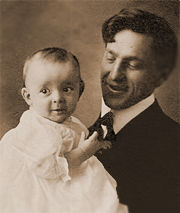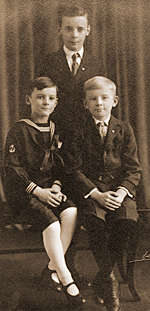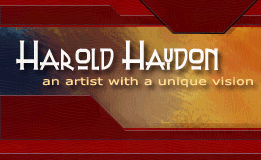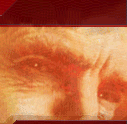
Harold (2 yrs) and his father,
Dr. Albert Eustace Haydon |
Born in Fort William, Ontario,
on April 22, 1909, Harold Emerson Haydon was one of three
sons. Harold (Hal) and his brothers, Edward Morgan (Ted)
Haydon (1912-1985) and Brownlee Walker Haydon (1914-1982)
all grew up to distinguish themselves in their respective
fields. Harold, of course, an artist, teacher and art critic;
Ted, initially a social worker from 1935-50 in the famous
Chicago Area Projects, changed careers in mid-life for
health reasons. A former University of Chicago track team
captain, he went back to the University as a coach, founded
the University of Chicago Track Club, went on to become
a two time Olympic Track and Field Coach and was inducted
into the National Track and Field Hall of Fame in 1975.
Brownlee, a writer, had an equally impressive career. Also
a product of University High School and the University
of Chicago, he initially tried emulating his brother Hal
by becoming an artist in metalcraft. Always a prolific
and creative writer, Brownlee turned to writing and editing
professionally, first for the University, then five years
as Assistant Foreign Editor for Business Week, next as
assistant to William Benton, publisher of Encyclopaedia
Britannica, and finally to the RAND Corporation as Assistant
to the President of Communications.

Hal's mother,
Edith Elizabeth Jones |
The boys' parents, Dr. Albert Eustace
Haydon (1880-1975) and Edith Elizabeth Jones (1879-1949)
were married in 1904. As parents they provided their sons
with a strong foundation in education, morality and social
service. Dr. Haydon, a writer and an ordained Baptist minister,
led religious camp revival meetings in Canada while the
boys were young. Later, in 1917, he moved the family to
Chicago, earning a University of Chicago Ph.D. in 1918
and joining the faculty that year to teach comparative
religion. Dr. Haydon later became Professor and Chairman
of the Department of Comparative Religion, and then Leader
of the Chicago Ethical Society.
Harold was raised during the era
of Progressivism, Social Reform, Settlement Houses and
Liberal Protestantism. During that time, profound changes
were occurring throughout the entire fabric of society.
Beginning in the late 19th century, new developments in
science and technology, rapid growth of cities, increased
disparity in the distribution of wealth, rampant political
corruption, rising exploitation of workers and much more
produced wide ranging reform actions taken on a national
level in politics, business, education and religion. Many
of these reforms created new federal business regulations,
consumer and labor protection laws, child labor laws plus
an awakening sense of social responsibility and humanitarian
efforts to relieve suffering in slums and tenements.

(r-l) Brownlee, Harold
and Edward |
Also in the late 19th century, theorists
in education and religion expanded traditional boundaries
and became agents not only for social reform but also for
a broader, more inclusive worldview. The newly reinstituted
University of Chicago, which in addition to having strong
ties to both the Baptist Church and the YMCA, was also
an outgrowth of educational reform movements and the liberalism
of Progressivism. In fact the very formation of courses
and departments in universities for the study of comparative
religion was a direct outgrowth of the Progressivist spirit,
and when the new University of Chicago began its first
term in 1892, included were courses in comparative religion.
It was because the University's origins and philosophy
were synchronous with the progressive beliefs of Harold's
parents that they saw Chicago as a natural environment
to raise their sons. Turn of the century educational theories
also included new forms and experimental methods. One form
was informal, outdoor education, such as summer camp, where
social values like sharing, cooperation, teamwork and appreciation
for the natural world, were taught. They were also used
to develop aesthetic sensibilities in areas like theatre,
poetry, creative writing, crafts and the visual arts. Other
values such as citizenship, leadership, responsibility,
and caring for the well being of smaller and weaker individuals,
like younger campers, were also promoted as part of the
role of character building, which these camps took to be
their primary mission. For the Haydon boys, camp life became
a regular summer activity, first as campers themselves,
then as counselors.
This form of up-bring in a home
of liberal and reformist ideas taught fairness, justice,
ethical behavior, social service and strength of character
as the goals of all responsible adults in society. These
were the values Harold Haydon adhered to his entire life.
They made him continue for many years working with YMCA
camps helping to expand the aesthetic education of young
campers, directed him into the service of teaching for
the majority of his career, led him to join numerous artists'
organizations and unions, and later to become known as
one of the most positive and supportive art critics in
Chicago.
Haydon found creative outlets in
many facets of life. Throughout his career his art work
grew from drawings and paintings to include murals, mosaics,
mobiles, sculpture, stage sets, and book illustration,
to name a few. In addition he designed furniture and converted
a former perfume factory into a home. Like most artists
he began drawing and painting young, in his case at the
tender age of four. Writing was another discipline he trained
in early, probably a result of his father's influence.
He wrote essays, short stories, poems and plays throughout
childhood. But unlike most children, Harold continued these
creative endeavors into high school and college, contributing
drawings as well as short stories to school newspapers
and literary magazines. Clearly, as a young adult, Haydon
was developing a strong belief in the importance of aesthetics
in everyday life.
Supporting these awakenings was
Haydon's attendance at the University of Chicago's Laboratory
High School from which he graduated in 1926. Founded in
1896 on the progressive theories of John Dewey and soon
after incorporating those of Colonel Francis Parker, the
1920s are remembered as the Golden Age of the University
Lab Schools. Although Parker had died in 1902 and Dewey
had left for Columbia University in 1904, the schools thrived
by building on past successes and adapting to new challenges.
The schools' faculty worked in concert with the University
of Chicago's professors of education to develop new and
effective educational methods. In fact, research and publishing
were so strongly encouraged among the lab school's faculty
that they became some of the most influential leaders in
the field of childhood education.
By Harold's time, the schools had
attracted some of the most talented teachers available.
Also noteworthy was the schools' introduction of the "unit-mastery" method
of teaching, which was in full bloom during the 1920s under
the direction of the new superintendent, Henry Clinton
Morrison. Morrison did not invent "unit-mastery" but
popularized it nationally when it proved most successful
on the high school level. Grades were discouraged and emphasis
placed on learning cohesive units of related information
and successive testing to determine when mastery of a "unit" was
gained. It was immensely influential and "inspired
teachers around the country to give up their practice of
drilling students for memorized facts. Instead, teachers
learned how to inspire students to learn information as
part of larger units of knowledge."
Harold remembered high school as
having no homework and giving no exams. It was true that
there was no homework since students were expected to work
through all their lessons during class time, but as for
exams, they may not have had mid terms or comprehensive
final examinations in their classes, but they were certainly
subjected to a constant battery of tests as part of the "unit-mastery" method.
More importantly, the method approached learning from the
perspective of understanding the "big-picture" first.
Rather than students memorizing endless details of dates
and places, the "details" were learned in support
of the broader concept. Learning to think in broad terms
allows one to see patterns and influences in the history
of human events as well as the impact of new developments
in scientific and technological knowledge. The creative
thinking and intellectual freedom engendered by these innovative
methods reinforced Haydon's natural abilities and added
to the confidence he needed to see the "big-picture" and
make the intellectual leap necessary to reach his binocular
vision theory of art.
|



